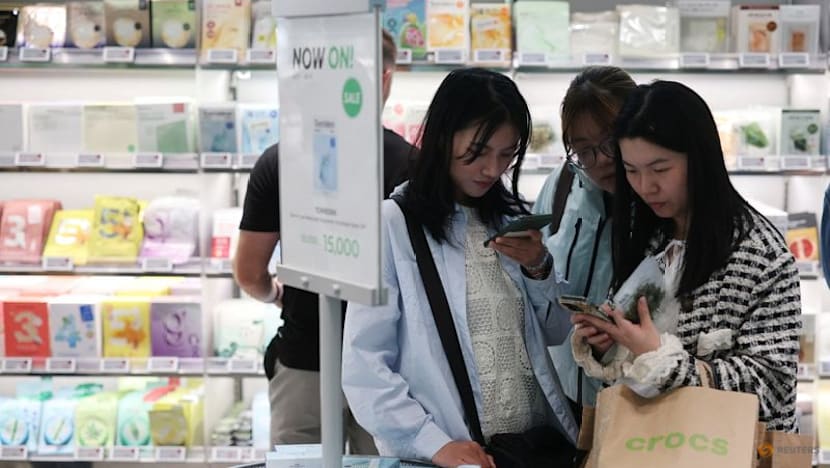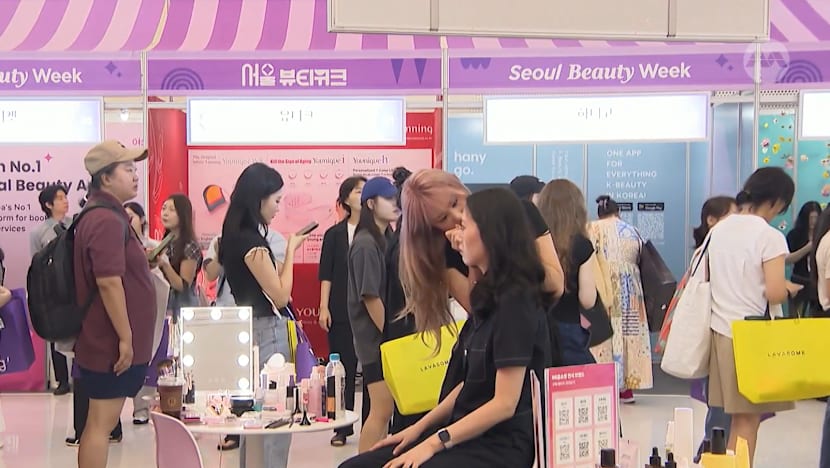US tariffs pose new threat to South Korea’s booming K-beauty industry
Korean cosmetics exported to the United States are now subject to a 15 per cent tariff.

Foreign tourists shop at an Olive Young store in Seoul, South Korea, April 28, 2025. REUTERS/Kim Hong-Ji

This audio is generated by an AI tool.
SEOUL: Korean beauty products, once relatively unknown outside Asia, now compete with some of the biggest names from France and the United States.
South Korea’s cosmetics exports jumped 20 per cent to a record US$10.28 billion last year, according to government data. The surge was driven by the international popularity of K-pop, Korean dramas, and a global fascination with Korean skincare products.
The nation is now the third-largest exporter of beauty products worldwide and the top exporter to the US.
But this beauty boom now faces a new hurdle.
On Aug 29, the US abolished a tax exemption on small packages valued at US$800 or below entering the country under new import regulations.
The move, which means imported Korean cosmetics are now subject to a 15 per cent tariff, could hurt South Korea’s small but fast-growing indie beauty product industry.
LIMITED IMMEDIATE IMPACT
Kolmar Korea – a major manufacturer that produces cosmetics for over 1,000 brands globally, including independent labels and global giants – said the immediate impact of the tariffs on sales has been limited.
However, it warned that the pressure could escalate.
"Tariffs are something that brands themselves have been absorbing, and some are still trying to deal with it. Right now, the volume of products crossing the tariff threshold isn’t big enough to be seriously affected,” said Han Sang Keun, the company’s vice president of research and development.
“We are Korea’s number one exporter, but for tariffs to really impact us, the volume would have to be much larger," he noted.
To mitigate the risks, Kolmar has invested in local production facilities in the US where it manufactures some K-beauty products for the American market.
This not only helps offset tariff costs but also shortens delivery times for American customers.
Han said Korean brands will eventually become established and recognised as mainstream global brands in the US.
“Once that happens, issues like price gaps and delivery times become critical. Production has to happen locally to be faster and more efficient,” he added.
“For small volumes – one or two products – shipping and paying tariffs is fine. But when you’re talking tens of thousands or millions, local production becomes much more efficient.”
Other South Korean brands, such as start-up Lillycover, said they can ride out the impact of US tariffs, given the popularity of K-beauty products.
The company recently created a smart skincare device powered by artificial intelligence and big data, designed to analyse users’ skin types and recommend customised care.
“Regarding the US tariffs, we are flexible,” Cliff Kim, a senior manager at Lillycover’s international sales department, told CNA.
“We can lower prices, negotiate with clients or offer additional bonuses. I am confident that we can record sales exceeding that 15 per cent impact.”

US-based buyers are also looking for ways to reduce the tariff burden.
Some, like RBB Studio’s CEO Roh Sun Min, are shifting sourcing strategies.
"Previously, I sometimes sourced through distributors rather than directly from brands. But distributor prices are higher, which raises tariffs, (so) we are shifting towards direct import from brands to reduce costs and address tariff issues," he said.
In July, the US agreed to lower its blanket tariff rate on South Korean products from 25 per cent to 15 per cent in exchange for South Korea investing US$350 billion in American industries.
However, Seoul and Washington have yet to reach a deal.
Despite the trade tensions, many in the industry remain optimistic, with South Korea’s beauty sector continuing to attract global consumers with its innovation, trend-setting products and cultural influence.
But how much further K-beauty can expand – and how quickly – may now depend on how well it navigates these new trade barriers.

















